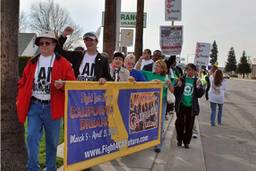Two efforts to form labor unions in Sacramento underscore a crucial point for the millions of Americans interested in securing stable, better-paying jobs through a union: it’s a lot easier if you work in the public sector.
In September, the Sacramento County Management Association — a professional organization that represents more than one-third of all non-union managers in the county — decided to give its members a chance to gauge their interest in forming a union.
If approximately 300 managers (who oversee workers delivering county services in airports, courts, hospitals and parks) sign cards expressing interest in voting to unionize by mid-December, a formal vote will be held early next year. (The association began collecting cards nearly one month ago.)
What set this process into motion was an informal SCMA straw poll at a spring luncheon, which indicated that 46 percent of attendees were interested in forming a union, said Sue Elliott, the association’s president and chief of administrative services for the Sacramento District Attorney’s Office.
“This decision is predicated upon the fact that the [county] has called into question management benefits that were given in lieu of pay raises over the years,” Elliott said. Those benefits range from cost-of-living-adjustments to sick and vacation days and 401k retirement plans.
In Sacramento County, non-union managers are more at-risk of employer-directed job, wage and fringe benefit cuts than their union counterparts. Why? The latter’s collective-bargaining agreements require negotiated changes to labor contracts.
The big question is: Will the county run a campaign to oppose a pro-union vote by these unrepresented managers if it comes to pass? If the past is any guide, the answer is probably not.
Research by Professor Kate Bronfenbrenner, director of labor education research at Cornell University’s School of Industrial and Labor Relations, shows that between 1999 and 2003, private employers used nearly five times the number of anti-union tactics as public employers.
“In 48 percent of public-sector campaigns,” she notes in her 2009 report “No Holds Barred: The Intensification of Employer Opposition to Organizing,” “the employer did not campaign at all – no letters, no leaflets, and no meetings.”
Meanwhile, in the same city
Contrast that with the ongoing struggle by workers at the Blue Diamond Growers almond processing plant in Sacramento.
After the International Longshore and Warehouse Union Local 17 began a campaign to organize workers the five years ago, Blue Diamond hired a firm to make employees fearful of voting to join the union. To shorten a half-decade story, the plant remains union-free today.
The Blue Diamond campaign fits into a workplace trends across the United States. American employers more than doubled their use of anti-union tactics against employees attempting to form unions between 1999 and 2003, according to Bronfenbrenner. In “No Holds Barred,” she analyzed a random sample of 1,004 National Labor Relations Board (NLRB)union election campaigns, and conducted in-depth surveys with head union organizers in 562 of these campaigns.
Sixty-three percent of employers use mandatory one-on-one, anti-union meetings with employees. Further, 57 percent of employers threatened to close the workplace, 47 percent of employers issued threats to slash benefits and wages, while 34 percent of employers fired workers during union organizing drives.
“Both the intensity and changing character of employer behavior, as well as the fundamental flaws in the NLRB process,” Bronfenbrenner reported, “have left us with a system where workers who want to organize cannot exercise that right without fear, threats, harassment, and/or retribution.”
Under the NLRB election process, 276,353 workers organized in 1970. By 1999, the year that Bronfenbrenner’s new study begins, 106,699 workers won union representation through elections. In 2003, just 71,427 workers organized.
According to her findings, the decline is due to employer behavior: threats, interrogation, promises, surveillance and retaliation for union activity. (Bronfenbrenner confirmed every unfair labor practice mentioned by survey respondents through Freedom of Information Act requests made at the NLRB.)
Quite simply, freedom of speech is not particularly free for American workers. Bronfenbrenner writes:
[E]mployers have control of the communication process. In today’s organizing climate they take full advantage of that opportunity to communicate with their employees through a steady stream of letters, leaflets, emails, digital electronic media, individual one-on-one meetings with supervisors, and mandatory captive-audience meetings with top management during work time.
Private employers have launched a pre-emptive control system to neuter union campaigns, emphasizing “interrogation and surveillance to identify supporters.” If that fails, according to Bronfenbrenner, “threats and harassment” follow “to try to dissuade workers from supporting the unions.”
Unsurprisingly, the union election win-rate for public-sector employees is nearly double that of private-sector workers.
The public sector offers a clear alternative to the private-sector, where workers face layoffs and speed-ups for those remaining on the payroll. It is simple: allow employees to decide whether or not they want to organize, without intimidating them.
If the Employee Free Choice Act — as originally written, with a provision allowing employees to organize via “card-check” if they wish to — were passed by Congress, this public-sector alternative would become a private-sector reality.








